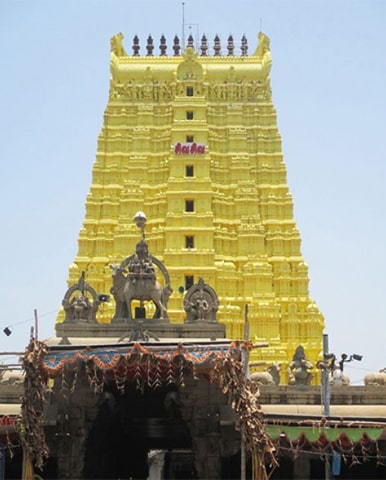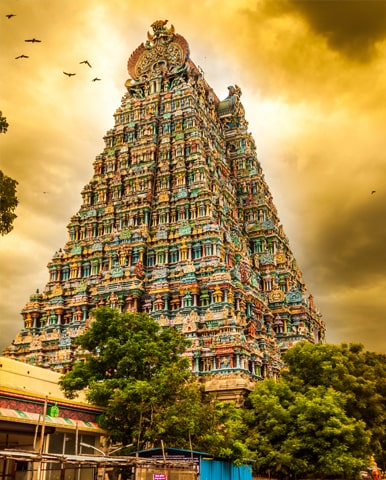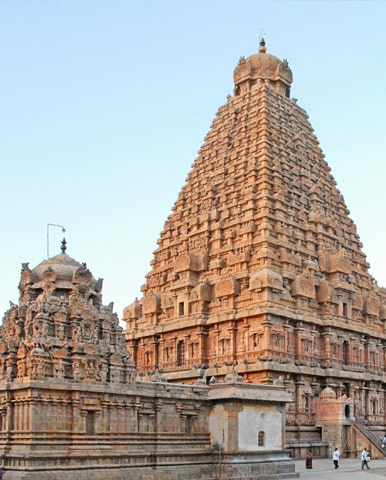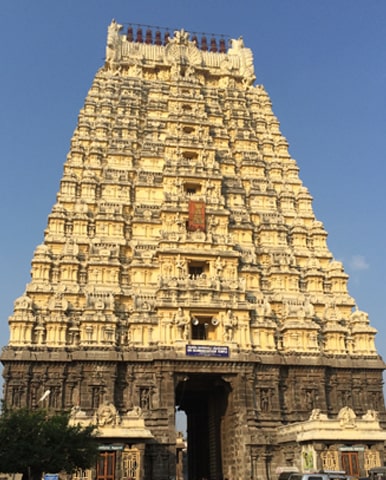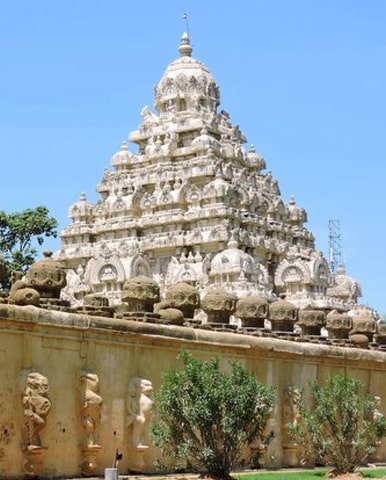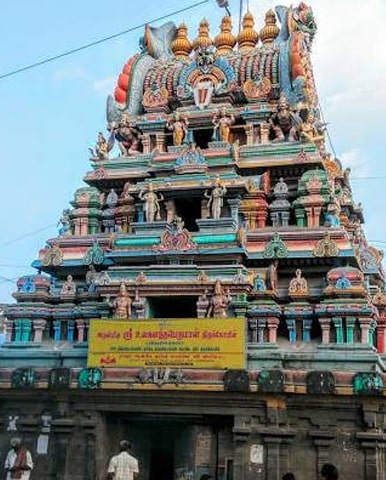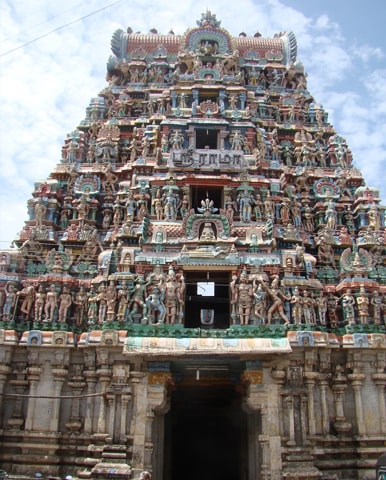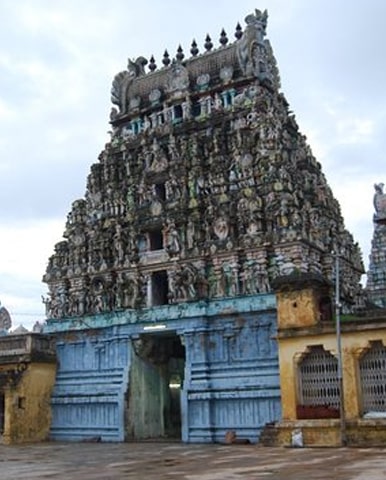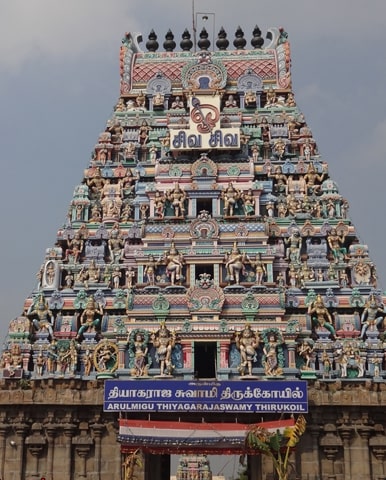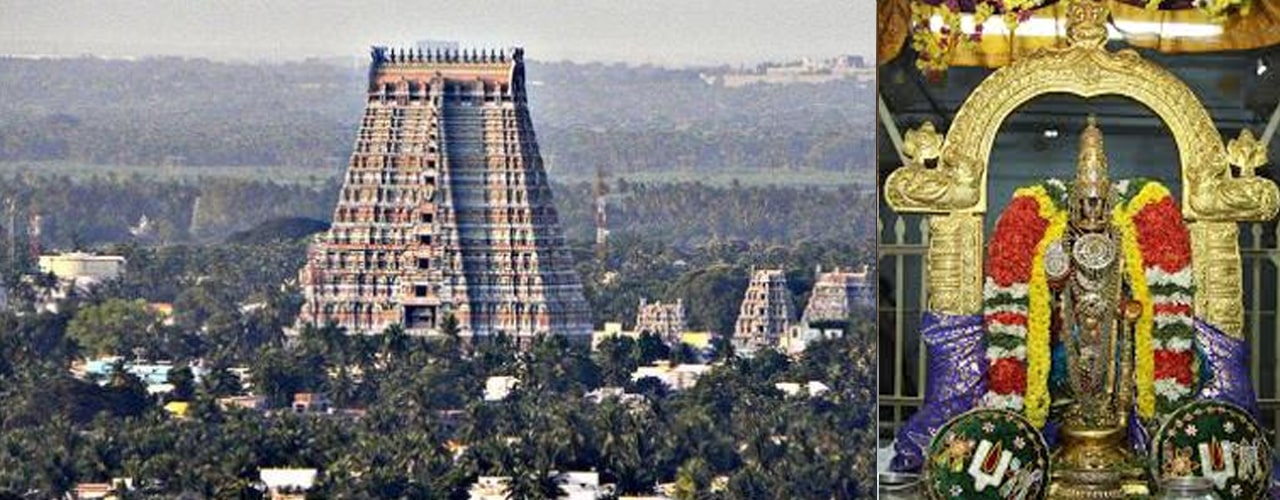
Sri Ranganatha Swamy Temple, Srirangam
The Sri Ranganathaswamy Temple is a Hindu temple dedicated to Ranganatha, a form of the Supreme God, Maha Vishnu, located in Srirangam, Tiruchirapalli, Tamil Nadu, India.Constructed in the Dravidian architectural style, the temple is glorified by Alvars in their Divya Prabhanda and has the unique distinction of being not only the foremost among the 108 Divya Desams dedicated to Vishnu,but also the largest functioning Hindu temple in the world. The Place Srirangpatna had the name of the Srirangapuri in the early ages later it got the name of the Srirangapatna. The town is an island being surrounded by the river Cauvery. In this town, there is the temple of Sri Ranganatha. Sri Lakshmi Narasimha, Sri Gangadereshwara, Sri Jyothirmaheshwara and other small temples. Among them, the main temple is that of Sri Ranganatha. The inner apartment of SriRanganatha temple was built in 817 CE by a lady by name Hambi, of the class of dancers in the year 894 CE.
It is one of the most illustrious Vaishnava temples in South India rich in legend and history. The temple has played an important role in Vaishnavism history starting with the 11th-century career of Ramanuja and his predecessors Nathamuni and Yamunacharya in Srirangam.Its location, on an island between the Kollidam and Kaveri rivers,has rendered it vulnerable to flooding as well as the rampaging of invading armies which repeatedly commandeered the site for military encampment.The temple was looted and destroyed by the Delhi Sultanate armies in a broad plunder raid on various cities of the Pandyan kingdom in early 14th century. The temple was rebuilt in late 14th century,the site fortified and expanded with many more gopurams in the 16th and 17th centuries.It was one of the hubs of early Bhakti movement with a devotional singing and dance tradition, but this tradition stopped during the 14th century and was revived in a limited way much later. The temple occupies an area of 155 acres (63 ha) with 81 shrines, 21 towers, 39 pavilions, and many water tanks integrated into the complex making it the world’s largest functioning Hindu temple.The temple town is a significant archaeological and epigraphical site, providing a historic window into the early and mid medieval South Indian society and culture. Numerous inscriptions suggest that this Hindu temple served not only as a spiritual center, but also a major economic and charitable institution that operated education and hospital facilities, ran a free kitchen, and financed regional infrastructure projects from the gifts and donations it received.
The Srirangam temple is the largest temple compound in India and one of the largest religious complexes in the world.Some of these structures have been renovated, expanded and rebuilt over the centuries as a living temple. The latest addition is the outer tower that is 67 metres (220 ft) tall, completed in 1987.Srirangam temple is often listed as one of the largest functioning Hindu temple in the world, the still larger Angkor Wat being the largest existing temple.The temple is an active Hindu house of worship and follows Thenkalai tradition of Sri Vaishnavism. The annual 21-day festival conducted during the Tamil month of Margazhi (December–January) attracts 1 million visitors. The temple complex has been nominated as a UNESCO World Heritage Site, and is in UNESCO’s tentative list.
The Temple was first Built by Dharma varma chola Then, Later Kaveri river flood destroyed the temple vimanam and later the Early Cholas King Killivalavan Rebuilt the temple complex present today. Beyond the ancient textual history, archaeological evidence such as inscriptions refer to this temple, but these stone inscriptions are from late 1st millennium CE.The inscriptions in the temple belong to the Chola, Pandya, Hoysala and Vijayanagar dynasties who ruled over the region. These inscriptions range in date between the 9th and 16th centuries. During the period of invasion and plunder by the Ala ud Din Khilji’s Muslim general Malik Kafur and his Delhi Sultanate forces in 1311, the Arabic texts of the period state that he raided a “golden temple” on river “Kanobari” (Kaveri), destroyed the temple and took the plunder with the golden icon of the deity to Delhi. According to Steven P. Hopkins, this is believed to be the Ranganathaswamy Temple.
The Tamil texts that followed offer various inconsistent legends on how the temple regained the Vishnu icon. According to one found in Koil Oluku, a young girl had vowed to fast till she had seen the icon.She followed the Muslim army as it returned with the loot back to Delhi. There she sneaked into the palace and saw that the Sultan’s daughter had fallen in love with the image. The young girl returned to Srirangam and told the priests about what she had seen in Delhi. The priests went with musicians to Delhi, found the icon in capriciously playful possession of the Sultan’s daughter, day and night.They sang and danced before the Sultan to return the icon, and he gave it back which upset his daughter. To console the daughter, the Sultan sent in his army again to bring it back, but this time they were not successful.According to other versions, the Muslim daughter followed the icon from Delhi to Srirangam on a horse, symbolizing that love brought back the icon after the war had taken it away.
Share This Post:
How to reach
- By Road: Trichy Central bus stand has direct services to most parts of Tamil Nadu. From the bus stand, tourists can avail local buses, taxi, auto rickshaw to reach Srirangam. City Bus service to all places of tourist interest from Central Bus Stand and from Chinthamani -Main Guard Gate Bus Stand (Both in Trichy). Tourist Taxis andAuto Rickshaws are also available at reasonable rates. Route No. 1 of the City bus service runs between Srirangam and Central Bus stand. This route starts from Trichy Central Bus Stand and goes via Trichy Junction Railway Station, Palakkarai Rettai pillaiyar Kovil street, Main Guard Gate, Chatram Bus Stand, Cauvery River Bridge, Mambazha salai, Thiruvanaikkovil and ends at Srirangam Bus Stand near the Srirangam Therkku vaasal (South entrance to the temple). There is a bus for every 5 minutes and the bus service is round the clock.
- By Train: Srirangam has a railway station that can be reached from Chennai through any of the major trains travelling in the Chennai-Kanyakumari railway track and the approximate journey time from Chennai is about 5 hours and 10 minutes (320 km). Only selected trains stop at Srirangam and rest at Tiruchirappalli junction. There is bus service from Tiruchirapalli Junction to Srirangam Temple every 5 minutes throughout the day. At night bus frequency is half an hour.
- By Air: The nearest airport is Tiruchirappalli International Airport.
Related Temples
How to reach
- Nearest airport is Tiruchirappalli International Airport
- Nearest railway station is Srirangam
- Nearest bus stations are Trichy and Chinthamani

